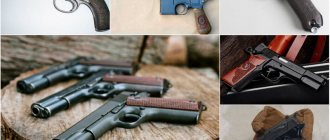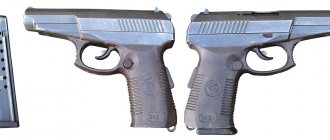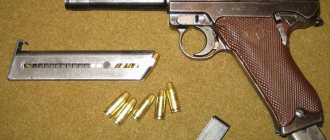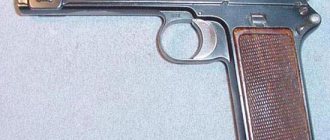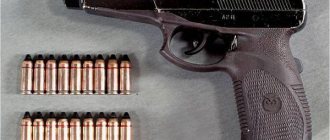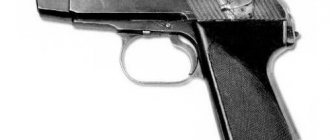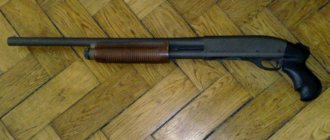Type of semi-automatic pistol
| IZH-35 | |
| IZH-35M | |
| Type | semi-automatic pistol |
| Place of origin | USSR |
| Production history | |
| Designer | Yarygin V. A.[1] |
| Designed by | 1973–1978 |
| Manufacturer | Izhevsk Mechanical Plant[1] |
| Produced | since 1978[1] |
| Characteristics | |
| Weight | 1.34 kg |
| Length | 300 mm |
| Barrel length | 156 mm |
| Cartridge | .22 Short (IZH-34) .22 LR (IZH-35) |
| Feeding system | 5-round magazine |
| Attractions | adjustable iron sights |
In IZH-35
(
IZH-35
) is a Soviet-designed target pistol for competitive shooting sports (including the Olympic Games).[1][2]
Purpose
The sports self-loading pistol chambered for a long 5.6 mm caliber cartridge, model IZH-35, is intended for sports training shooting at figured and round targets at a distance of 25 meters.
The pistol must be operated in the conditions of sports shooting ranges or shooting ranges using 5.6 mm caliber target rimfire rifle cartridges or 5.6 mm caliber "Extra" target rimfire rifle cartridges.
Diagram of the pistol mechanism: 1 - pistol frame, 2 - bolt, 3 - barrel, 4 - upper cover 5 - block, 6 - trigger base, 7 - trigger rod, 8 - magazine, 9 - magazine latch, 10 - lower cover, 11 - return spring, 12 - rod, 13 - front sight, 14 - sight, 15 - trigger, 16 - sear I, 17 - sear II, 18 - trigger hook, 19 - hook screw, A, B, C, D - adjusting screws .
Product composition
The list of assembly units and parts of the pistol is shown in Table 2.
Table 2.
| Designation in the figure | Name | Qty | Designation in the figure | Name | Qty |
| 1 | Pistol frame | 1 | 38 | Sear I | 1 |
| 2 | Axis of the base of the descent | 6 | 40 | Fuse spring | 1 |
| 3 | Magazine latch | 1 | 41 | Fuse | 1 |
| 4 | Latch spring | 1 | 42 | Spring sear II | 1 |
| 5, 16, 49, 56, 69 | Pin | 5 | 43 | Sear II | 1 |
| 6 | Compensator | 1 | 44 | Combat spring | 1 |
| 7 | Insert | 2 | 45 | Axis | 2 |
| 8 | Front sight | 1 | 46, 62, 71, 74 | Screw | 5 |
| 9 | Front sight screw | 1 | 47 | Reflector | 1 |
| 10 | Bottom cover lock | 1 | 48 | Shoe mounting screw | 1 |
| 11, 59 | Spring | 2 | 50 | Sight base | 1 |
| 12 | Gnetok | 1 | 51 | Sight base bend | 1 |
| 13 | Compression spring | 1 | 52 | Compression spring | 1 |
| 14 | Trigger force adjustment screw | 1 | 53 | Horizontal adjustment screw | 1 |
| 15 | Release base spring | 1 | 54 | Rear sight spring | 1 |
| 17 | Gate | 1 | 55 | Vertical adjustment screw | 1 |
| 18 | ejector | 2 | 57 | Ball | 1 |
| 19 | Ejector bend | 1 | 58 | Ball spring | 2 |
| 20 | Ejector spring | 1 | 60 | Rear sight | 1 |
| 21 | Striker pin | 1 | 61 | Crawler | 1 |
| 22 | Drummer | 1 | 63 | Sight axis | 1 |
| 23 | Base of descent | 1 | 64 | Store body | 1 |
| 24 | Insert | 2 | 65 | Feeder | 1 |
| 25 | Adjustment screw | 2 | 66 | Magazine spring | 1 |
| 26 | Trigger | 1 | 67 | Magazine cover | 1 |
| 27 | Hook screw | 1 | 68 | Store button | 1 |
| 28 | Release rod spring | 1 | 70 | Left cheek | 1 |
| 29 | Trigger pull | 1 | 72 | Right cheek | 1 |
| 30 | Block | 1 | 73 | Fungus | 1 |
| 31 | Shield screw | 1 | 75 | Bottom cover | 1 |
| 32 | Pad shield | 1 | 76 | Top cover | 1 |
| 33 | Trigger axis | 1 | 77 | fungus creeper | 1 |
| 34 | Trigger | 1 | 78 | Stock | 1 |
| 35, 39 | Axis | 2 | 79 | Return spring | 1 |
| 36 | Spring whispered I | 1 | 80 | Insert | 1 |
| 37 | Pusher | 1 | 81 | Locking spring | 1 |
Specifications
Table 1.
| Parameter name | Meaning |
| Caliber, mm | 5,6 |
| Length, mm, no more | 300 |
| Height, mm, no more | 150 |
| Width, mm, no more | 50 |
| Trigger force, N, adjustable | 10…15 |
| Trigger stroke, mm, adjustable | 1…5 |
| Length of the aiming line, mm, no more | 220 |
| Magazine capacity, pcs. | 5 |
| Weight, kg, no more | 1.36 |
Typical faults and methods for their elimination
If, after the expiration of the warranty period or warranty shooting, any defects arise in the pistol that affect its performance, then, using the recommendations, the pistol can be corrected independently or with the help of a gunsmith.
| 1. There is no release of the trigger from cocking. | |
| a) the trigger on the base of the trigger has moved. | Loosen the screw securing the trigger, move the latter to the desired position and secure it with the screw. |
| b) the trigger mechanism is not adjusted | Turn out the screw for adjusting the preliminary descent stroke until the trigger rod engages the protrusion of the sear II. While pressing the trigger, turn out the emergency release screw until the trigger is released from the cocking position. |
| c) misadjustment of the engagement value of the combat platoon of sear I with the combat platoon of sear II | Replace the sear engagement adjustment screw insert from the spare parts and adjust. |
| 2. Missing a cartridge when firing. | |
| a) weak shutter recoil | Thoroughly clean the chamber and lubricate the gun. |
| b) increased, hardened carbon deposits in the chamber | |
| c) an unlubricated gun | |
| d) cartridge jamming in the magazine | Replace the magazine from the spare parts. |
| 3. Automatic shooting. | |
| a) insufficient engagement of sear I with sear II | Increase the sear engagement with the trigger stroke adjustment screw. |
| b) upset or kink of the locking spring | Replace the locking spring from the spare parts. |
| c) sear spring draft II | Replace the sear spring II from the spare parts. |
| d) wear of the combat platoon sear II | Replace sear II from the spare parts. |
| 4. Misfires. | |
| a) settlement or break of the mainspring | Replace the mainspring from the spare parts. |
| b) small output of the firing pin | Replace the firing pin from the spare parts. |
| c) the firing pin does not move in the bolt | Clean the firing pin and the hole in the bolt from sediment. |
| 4.1 The shutter does not reach its extreme forward position. | |
| a) settling or fracture of the return spring | Replace the return spring from the spare parts. |
| b) deformation of the cartridge during feeding | Increase the bullet lead-in radius on the barrel to 1.2 mm, no more. |
| 5. The cartridge case is pinched after the shot. | |
| a) weak recoil, increased carbon deposits in the chamber, unlubricated gun | Thoroughly clean the chamber and lubricate the gun. |
| b) breakage or deformation of the ejector or ejector bend | Replace the ejector or ejector bend from the spare parts. |
| 6. Failure to advance the chamber when feeding. | |
| a) the firing pin does not move in the bolt | Clean the firing pin and the hole in the bolt from sediment. |
| b) cartridge jamming in the magazine | Replace the magazine from the spare parts. |
| c) increased output of the striker to the extreme forward position | Replace the firing pin from the spare parts. |
| d) sticking the cartridge into the bullet entry radius of the barrel | Increase the bullet lead-in radius on the barrel to 1.2 mm, no more. |
| 6.1 Sticking the cartridge into the upper frame of the chamber. | |
| a) store wings are located low | Replace the magazine from the spare parts. |
| b) the wings of the store spread | Tighten the front wings of the magazine to a size of 5.6+0.2mm or replace the magazine with spare parts. |
Read cyber fiction online on Phantom Worlds
Operating procedure
When preparing a pistol for shooting, you must:
— perform incomplete disassembly of the pistol;
— remove grease from the barrel bore, from the magazine parts and from the outer surfaces of the gun;
— carry out an external inspection of the pistol parts for damage, cracks, dents, etc.;
- assemble the pistol;
— check the functionality of the gun.
Before performing an exercise with a pistol, you must:
— equip the magazine with five rounds;
- take the pistol by the handle and insert the magazine under the latch;
— move the shutter to the rearmost position and release;
— check the presence of a cartridge in the chamber by retracting the bolt by 2-3 mm.
When firing a pistol at temperatures below 0°C, it is recommended to lubricate the cartridges with a thin layer of gun lubricant.
Safety instructions
Sports weapons belong to the category of products of increased danger in operation and, despite the fact that the design of the pistol is equipped with various safety devices, careless handling of it can lead to tragic consequences.
Strictly follow the requirements set out in the “Operating Procedure” and “Maintenance” sections when operating the gun.
When using the pistol it is prohibited:
- allow persons to shoot from a pistol who have not studied the pistol and have not mastered the rules and techniques of shooting and the requirements for safety measures;
- fire from a faulty pistol;
- use homemade cartridges and cartridges not intended for this pistol;
- point the gun barrel at a person, regardless of whether the gun is loaded or not;
- turn off the automatic fuse while outside the line of fire or a special room for inspecting weapons;
- leave the pistol loaded outside the firing line before and after shooting,
- leave the pistol with the firing mechanism cocked.
After finishing shooting, without changing the direction that was when shooting:
- separate the magazine with your free hand;
- check that there is no cartridge in the chamber by retracting the bolt by 3...5 mm;
- unload the pistol with a cartridge in the chamber and magazine;
- release the trigger.
- Do not leave the gun unattended!
Maintenance
Correct handling and timely maintenance of the gun increases its service life and guarantees its reliable operation. If this is not necessary, you should not completely disassemble the pistol.
Partial disassembly of the pistol should be carried out in the following order:
— unscrew the cheek screws 6 with the screwdriver attached to the gun and separate them from the cheeks;
— recess the lock of the bottom cover 4 and separate the bottom cover 1, pushing it forward;
— rest the gun with the back of it on some surface, move the bolt 3 to the rear position and, holding it, separate the top cover 2, lifting its front part up. After separating the cover, separate the bolt by lifting its back part up;
— separate the return spring 11 from the rod 12.
The pistol is reassembled in the reverse order. Having assembled the pistol, you need to pull the trigger.
After assembling the pistol, it is important to check its functionality.
This checks:
— the ability to retract the bolt to the rearmost position and vigorously move it to the frontmost position under the action of the return spring;
— mandatory cocking of the hammer by retracting the bolt with the trigger lowered and pulled out and safety 7 not released and pressed in the direction of arrow A;
— absence of the trigger being disengaged when the trigger is pressed and the safety is not released;
— the presence of the hammer being pulled from cocking when the trigger is pressed while the safety is pulled in the direction of arrow A or the pistol grip is grasped with your hand.
If the gun does not meet any of the above requirements, it must be repaired or adjusted. The pistol may be allowed to fire only after the defects have been corrected.
The trigger mechanism must be adjusted:
— idle descent — screw A;
- emergency escapement - screw B;
- working stroke of the descent - screw B;
- descent forces - screw G.
To adjust the trigger force, it is necessary to remove the lower and upper covers 1 and 2.
To adjust the size from the back of the handle to the trigger:
— loosen the hook screw 19, move the trigger 18 to the desired position along the guides of the trigger block and tighten the hook screw.
The sighting line on the pistol is aligned vertically and horizontally with micrometric screws located on the base of the sight (item 14).
Clean and lubricate pistol parts immediately after shooting.
The following materials are recommended for cleaning gun parts:
- clean soft rags or gauze;
- tow - for cleaning the bore;
- gun oil.
The gun must be lubricated with a thin layer of gun oil.
Read cyber fiction online on Phantom Worlds
Design and principle of operation
The mechanism diagram of the IZH-34M pistol is shown in Fig. 3.
The pistol has a sufficient number of adjustments to ensure ease of use, taking into account the individual characteristics and wishes of sports shooters.
The operation of the automatic pistol is based on the principle of blowback. The automatic cycle includes extraction and deflection of the cartridge case after the shot, cocking of the firing mechanism and chambering of the next cartridge from the magazine into the chamber. The reliability of the trigger mechanism with small sear engagements has been increased due to the introduction of spring locking of the sear II.
The stability of the pistol when fired is improved due to the release of part of the powder gases through special holes in the barrel bore.
The safety of handling the pistol is ensured by a special safety device, which is turned off when the safety lever 15 (see Fig. 3) is pressed in the direction of arrow A, i.e., a shot is possible only when the handle is tightly grasped with the hand. Additionally, the design of the pistol provides for blocking from firing when the bolt is not closed.
Also in this section:
Single-barrel hammerless hunting shotgun IZH-18
01.01.1970
Section: "Directory"
Excerpts from the passport of the IZH-18 gun.
Read →
History of the creation of IZH-27
Back in 1970, under the leadership of a very talented weapons designer - A.A.
Klimov, the IZH-27 (now MP-27) was developed, which, without exaggeration, can be called the most popular smooth-bore hunting rifle. Firstly. IZH-27, and currently MR-27, is still in production. Secondly, more than 3.5 million units of IZH-27 models were produced in a wide variety of configurations and modifications. This is a record among currently produced domestic hunting rifles
General conclusion
Both of these guns are of quite high quality and reliable, and it is very difficult to recommend either one. Rather, when choosing, an individual factor will play a role: like it or not, that is, this is a purely personal choice. In any case, no matter what gun is chosen, its owner will never regret his choice.
Comparative video review of IZH 27 and TOZ 34
Previous post Spanish Hound
Next entry Sig Sauer MCX air rifle
Short-barreled weapons
Glock 17 pistol Glock 34 pistol Glock 34 Gen.4 pistol in tactical body kit (temporarily unavailable) Glock 35 pistol CZ-75 SP01 Shadow pistol Tanfoglio P19 pistol (new) Browning High-Power (HP) pistol (temporarily unavailable) Smith pistol & Wesson Model 639 (new) Beretta 92 pistol (TAURUS PT 99) Colt 1911 pistol (9 mm) Colt 1911 14-round pistol (temporarily unavailable) Alfa Para revolver (Classic 9241) Yarygin pistol Walther P.38 pistol Walther P22 pistol Walther PP pistol (new) Stechkin “S-APS” pistol with a holster-stock (new) MP-71 pistol (analogue of the Makarov pistol chambered for a service cartridge) S-TT pistol caliber (7.62x25) PKSK service pistol Service revolver TKB Pistol " Margolin" (MCM) Pistol TOZ-35M (for sections) Sports pistol IZH-35 (for sections) Sports and training pistol MCM-K "Margo" Makarov pistol (9x18 mm) Revolver TAURUS 94 cal. 22LR blued steel (temporarily unavailable) TOZ revolver - 49M (temporarily unavailable) MP-79-9TM "Makarych" pistol P226 TK-Pro pistol Modernized Makarov pistol Sig-Sauer P226 pistol ISSC M22 pistol GSh-18S pistol Colt M1873 PeaceMaker revolver Pistol Colt 1911 (.45 ACP) Pistol GRAND POWER X-CALIBUR (new)
Glock 17 pistol
Caliber, mm – 9×19 Length, mm – 186 Barrel length, mm – 114 Weight (without magazine), g – 625 Magazine capacity, pcs – 17
Glock 34 pistol
Caliber, mm – 9×19 Length, mm – 207 Barrel length, mm – 135 Weight (without magazine), g – 650 Magazine capacity, pcs – 17
Glock 34 Gen.4 pistol in tactical body kit
Caliber, mm – 9×19 Length, mm – 207 Barrel length, mm – 135 Weight (without magazine), g – 650 Magazine capacity, pcs – 17
Glock 35 pistol
Caliber, mm – 10×22 (.40 S&W) Length, mm – 207 Barrel length, mm – 135 Height, mm – 138 Width, mm – 30 Rifling – right-handed, hexagonal, pitch mm – 250 Weight (without magazine), kg – 0.695 Weight (curb), kg – 1020 Magazine, cartridges – 15 (optional 10, 17)
Pistol CZ-75
Caliber, mm – 9×19 Length, mm – 209 Barrel length, mm – 114 Weight, kg – 1,170 Magazine capacity, pcs – 18
Tanfoglio P19 pistol
The Tanfoglio P19 pistol is a copy of the Czech model - CZ 75/85. The main differences between the Tanfoglio P19 and its predecessor are the safety and slide stop flags located on both sides of the frame, which made shooting more convenient both with the right and left hands. The trigger mechanism also underwent some changes - the firing pin received an automatic safety device. The pistol grip and trigger guard have been improved to make it easier to hold the pistol with both hands.
The P19 turned out to be very comfortable to carry, which is typical for all long and fairly narrow pistols. This is of course not important for IPSC, but for IDPA or tactical training it matters. The pistol is completely black. The steel coating is thermal bluing, not paint, which is also important for aesthetes. The handle pads are black plastic and really comfortable.
Caliber, mm – 9×19 Length, mm – 208 Barrel length, mm – 113.8 Weight, kg – 1.15 Magazine capacity, pcs. – 16
Browning High-Power (HP) Pistol
Caliber, mm – 9×19 Parabellum Length, mm – 200 Barrel length mm – 118 Weight, kg – 0.885 Magazine capacity, cartridges – 13
Smith & Wesson Model 639 pistol
Models 439, 539 and 639 had very significant advantages for that time, such as small dimensions and weight, availability of a choice of design options, constant combat readiness combined with safety in handling, good shooting accuracy, high reliability of chambering of cartridges with expansive bullets, convenience retention and good controllability when firing, as well as fairly high quality manufacturing and surface treatment.
Caliber, mm – 9×19 Length, mm – 189 Barrel length mm – 102 Weight, kg – 0.78 Magazine capacity, cartridges – 8
Beretta 92 pistol
Throughout the production of the Taurus PT 99 pistol, its individual parts have undergone changes. The most notable change that made the Taurus PT 99 pistol safer was the addition of a safety trigger release. It is implemented quite conveniently and allows you to safely pull the trigger with a minimum of manipulations with the pistol. The pistol trigger is safely released using the safety switch, which has the ability to move downwards.
